War of the Spanish Succession
Battles of the War of the Spanish Succession (1701-1714)
Carpi - Chiari - Cremona - Kaiserswerth - Luzzara - Cádiz - Friedlingen - Vigo - Schmidmühlen - Ekeren - Höchstädt (1703) - Gibraltar - Speyerbach - Schellenberg - Bonn - Höchstädt (1704) - Vélez-Málaga - Cassano - Barcelona (1705) - Sendlinger Mordweihnacht - Calcinato - Ramillies - Turin - Castiglione - Almansa - Toulon - Lille - Oudenaarde - Malplaquet - Almenara - Saragossa - Brihuega - Villaviciosa - Denain - Rio de Janeiro - Barcelona
Wars of Louis XIV (1667-1714)
War of Devolution - Dutch War - War of Reunion - War of the Palatinate Succession - War of the Spanish Succession
The War of the Spanish Succession was a cabinet war fought between 1701 and 1714 over the inheritance of the last Spanish Habsburg, King Charles II of Spain. Charles II died childless on November 1, 1700, shortly before which he had installed a French candidate as his heir, Philip V. The latter actually ended up establishing the Bourbon dynasty, which still reigns today (albeit intermittently). Other powers of the time, however, did not want to accept this succession for a long time, because Philip was the grandson of the French king Louis XIV. They feared a concentration of power to their own disadvantage.
One of these powers was Austria, more specifically Emperor Leopold I as head of the Austrian Habsburgs. He was Holy Roman Emperor and had originally supported a candidate of his own. England and the Netherlands were also opposed to Philip's succession. They were the originators of the Hague Grand Alliance with the Emperor and the Empire. France's and Spain's allies, respectively, were at times Electoral Cologne, Savoy, and the Electorate of Bavaria.
In connection with this, there were rebellions in Royal Hungary and Transylvania under Francis II Rákóczi. These began as early as 1700, when the nobleman Francis II Rákóczi contacted Louis XIV of France and asked for support in an anti-Habsburg rebellion.
Queen Anne's War in North America between 1702 and 1713 - named after Queen Anne of Great Britain - also became part of the War of the Spanish Succession. It was the second of the four "French and Indian Wars" in which France and the Kingdom of Great Britain fought for supremacy in North America.
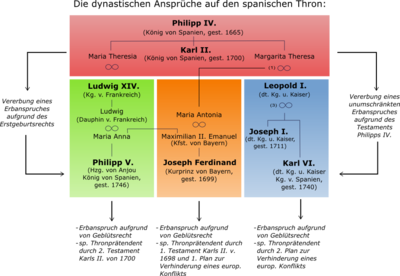
Previous story
Future succession to the Spanish throne
In the second half of the 17th century, the future succession to the Spanish throne became the subject of general attention of European diplomacy. King Charles II was childless. As soon as he died, the Spanish line of the House of Habsburg would cease to exist. Three possible candidates for the throne came into question: Philip of Anjou, Archduke Charles and Elector Prince Joseph Ferdinand of Bavaria.
Philip of Anjou was championed by his grandfather, the French King Louis XIV. Philip's great-grandmother, the Spanish Infanta Anne of Austria, was a daughter of the former Spanish King Philip III. (died 1621, grandfather of Charles II). Furthermore, Philip had Maria Teresa of Spain (died 1683) as his grandmother. She was descended from the House of Habsburg and had been the wife of the French King Louis XIV since 1660. She was the eldest daughter of Philip IV. (died 1665, father of Charles II), and her male descendants (including Philip) had legitimate claims to the Spanish crown.
Philip of Anjou's opponents feared a preponderance of France through the union of the vast resources of Spain and France. They rejected this claim to inheritance on the grounds that Mary Teresa of Spain had renounced her inheritance when she married Louis XIV. King Louis XIV, however, had this renunciation of inheritance declared invalid: In the marriage contract (1659) it had been agreed that Spain would pay 500,000 gold ecu for the renunciation of the inheritance. However, this payment had never been made.
Archduke Charles was the second son of the Roman-German Emperor Leopold I, head of the Austrian Habsburgs. Leopold had determined that the first son (Joseph I) should inherit him in Austria and also be elected Roman-German Emperor. The second son, Charles, was to succeed to the Spanish Habsburg inheritance. Several arguments were put forward in favour of Charles:
- In general, the House of Habsburg was a collateral line of the Spanish monarchy.
- Charles' father Leopold was also a grandson of Philip III of Spain, like Louis XIV of France.
- Charles' father Leopold was also the husband of Margarita Teresa. She was the younger daughter of the former Spanish king Philip IV and, unlike her half-sister Maria Teresa, had not renounced her inheritance when she married.
But even in the event that Archduke Charles became the heir in Spain, opponents feared too great a concentration of power. All the Habsburg lands would again come together in one house, as in the time of Charles V. Moreover, the elder brother Joseph I could have died, so that both the Austrian and the Spanish inheritance would have been in Charles's hands. (It was not foreseeable that Joseph would die surprisingly early actually already in 1711).
Alongside France and Austria, England was an important power of the time (already in personal union with Scotland, from 1707 united in real terms). King William III of Orange was also governor of the Seven United Provinces (northern Netherlands); this was a militarily and also politically influential position. England and the Netherlands wanted to prevent Spain and its colonies from falling to France or Austria. Therefore they urged the sick King Charles II to appoint a third candidate as heir: Elector Joseph Ferdinand of Bavaria. He was the son of the Elector Maximilian II. Emanuel of Bavaria and his first wife, Maria Antonia. She was not only the daughter of Emperor Leopold I, but also of his first wife, the Infanta Margarita Teresa of Spain. This made Joseph Ferdinand the great-grandson of Philip IV of Spain.
In addition, England and the Netherlands devised an extensive partition plan for the Spanish possessions in the southern Netherlands and Italy. In this way, France and Austria were to be compensated. However, Joseph Ferdinand died on 6 February 1699 (one year before King Charles II).
After this sudden death, William III and the French King Louis XIV concluded a new partition treaty on 25 March 1700. According to it, Archduke Charles would receive the Spanish crown. Philip of Anjou, Louis' grandson, would get Naples, Sicily, Guipuzcoa and Milan. This was tempting for France, as it had been seeking hegemony in Italy since the Italian Wars of the 16th century. However, Emperor Leopold I rejected the partition treaty. Therefore, Louis XIV did not feel bound by it either.
At the court in Madrid, envoys acted for the two remaining candidates. Finally, Charles II decided on a will (October 2, 1700) in which he named Philip of Anjou heir to the entire Spanish monarchy. Charles II died soon after, on 1 November.
Start of the war in Northern Italy
Louis XIV was reluctant to accept the will, realizing that both accepting and rejecting it would inevitably lead to war. Nevertheless, the French king saw no better alternative and allowed his grandson Philip to ascend the Spanish throne. The acceptance of the will was officially announced on November 16, 1700. On 24 November 1700, Philip of Anjou was proclaimed King Philip V of Spain at Versailles and (in absentia) at the Plaza Mayor in Madrid. On 18 February 1701 Philip made his solemn entry into Madrid, in May 1701 the estates of Castile paid homage to him, and in January and April 1702 respectively the estates of Aragon and Catalonia followed. The governor of the Spanish Netherlands, Max Emanuel of Bavaria, also had Philip's accession to power publicly celebrated as early as 20 November 1700. The maritime powers of England and the Netherlands under William of Orange and the councilor Heinsius, respectively, were not averse to recognizing the fait accompli in view of Louis XIV's explicit promise that France and Spain would not be united. In January and February 1701, the recognition of Philip V as King of Spain by England and the Netherlands respectively took place.
The imperial court in Vienna, on the other hand, was determined not to recognize the will without reservation. Negotiations with the French envoy de Villars were not broken off, but the diplomat Johann Wenzel Wratislaw was sent to London to win William of Orange over to a renewed Grand Alliance. Prince Eugene of Savoy was appointed commander-in-chief and the armament effort was intensified. The imperial efforts were initially aimed at winning the Duchy of Milan. According to Viennese interpretation, this had reverted to the empire as an imperial fief after Charles' death. An attempt by the imperial commissioner Count Castelbarco to take possession of the duchy for Leopold I failed on 11 December 1700 due to the resistance of the Spanish governor de Vaudémont and the Milanese Senate. Philip V recognized the imperial feudal sovereignty and formally requested enfeoffment with the upper Italian Spanish possessions, but this was rejected by the Imperial Council on 17 March 1701. On 11 May 1701 an imperial edict declared the reversion of all Upper Italian fiefs. In February 1701 Louis XIV sent troops into Upper Italy, and in the spring an army under the command of Prince Eugene crossed the Alps towards Milan. Thus the war in Upper Italy had de facto broken out.
Formation of the Hague Alliance and entry of the naval powers into the war
On 1 February 1701, Louis XIV had the succession claims of Philip V and his male descendants to the French throne solemnly confirmed by the Parisian Parliament. In doing so, he broke the important pledge that Spain and France should not be united under one crown, and at the same time violated the will of Charles II. At this time, Philip V was third in line to the French throne. On the night of February 5-6, 1701, French troops occupied eight barrier fortresses in the Spanish Netherlands in a surprise action. The action was justified by the lack of recognition of Philip V by the Netherlands. During 1701, the new Spanish government transferred several important trading privileges in Spain and the Spanish colonies (including the trade in African slaves) to French companies-to the detriment of the maritime powers. All in all, this led to a failure in the summer of 1701 of the conciliation negotiations that had been conducted between France and the Netherlands in the Hague since March. On September 7, 1701, a Grand Alliance Treaty was concluded between the Emperor, the Netherlands, and England. The English side was further disturbed by the fact that after the death of the exiled Catholic Stuart king James II in September 1701, Louis XIV recognized his son James Francis Edward Stuart (the old pretender) as the legitimate king of England, while in England the last living son of Queen Anna died at the same time, with which the Protestant line of the House of Stuart became extinct in the male line.
Situation in the Holy Roman Empire
After the many wars in the preceding decades (Dutch War 1672-1679, War of the Palatinate Succession, Great Turkish War 1683-1699) in which the Empire had participated, there was a certain war weariness and initially little motivation to enter a war that was predominantly perceived as a dynastic war of the House of Habsburg. French policy strove to exploit this to the best of its ability for its own ends, and the French envoy to the Diet of Regensburg, Louis Rousseau de Chamoy, never tired of constantly emphasizing Louis XIV's love of peace. However, a certain imperial patriotism and a distrust and need for security towards France had also developed due to the constant French wars of conquest, which played into the hands of imperial policy.
The greatest success of French diplomacy was the winning of Duke Max Emmanuel of Bavaria and his brother, Archbishop Joseph Clemens of Cologne as allies. The archbishop concluded a defensive alliance with France in February 1701 and the duke in March 1701. Another ally of France became Duke Anton-Ulrich of Brunswick-Wolfenbüttel, who felt politically set back by the previous elevation of the younger Guelph line, the House of Hanover to the electorate. The fourth French partisan in the empire became Duke Frederick II of Saxe-Gotha-Altenburg, who was won over primarily with promises of French subsidies.
Imperial policy also sought allies in the Empire at an early stage. On 15 November 1700, the so-called Prussian Contract was concluded with the Elector Frederick III of Brandenburg, in which the Emperor undertook to recognise Frederick's intended elevation of the Duchy of Prussia to a kingdom. In return, Frederick undertook to provide 8000 troops annually in return for subsidy payments of 100,000 imperial talers, which could also be deployed outside the empire, and to waive outstanding earlier claims. Under the influence of the Archbishop of Mainz and Bishop of Bamberg, Lothar Franz von Schönborn - by virtue of his office Archchancellor of the Empire - the Swabian, Franconian, Kur-Rhenish, Upper Rhine and Lower Rhine-Westphalian circles joined forces with the Austrian Imperial Circle, i.e. in effect the Emperor, to form an association in Nördlingen on 6/20 March 1702, which declared its adherence to the Hague Alliance on 24 March 1702. Only the Bavarian Imperial Circle kept away. On October 5, 1702, after deliberations of the Regensburg Diet and on the basis of a legal opinion, the Empire officially declared war on France.
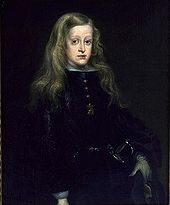
Charles II of Spain

Europe in 1701. The border of the Holy Roman Empire is shown dashed. Spanish possessions outside the Iberian Peninsula included the Spanish Netherlands, the Duchy of Milan, and the Kingdoms of Naples, Sicily, and Sardinia
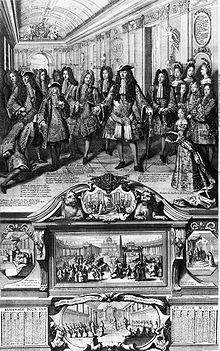
Louis XIV declares his grandson Philip of Anjou the new King of Spain at Versailles
History
The main acts of war took place partly simultaneously in the south of the Holy Roman Empire, in Flanders and Brabant, in Upper Italy and Spain. The War of the Spanish Succession was also one of the first conflicts to have an impact on the colonial territories of the respective powers. In particular, the war in North America, also known there as Queen Anne's War, was fought as a proxy war by the respective Native American auxiliaries of England and France, respectively. A truly coordinated global confrontation was not achieved until the War of the Austrian Succession from 1740 to 1748 and the Seven Years'War from 1756 to 1763.
1701
Philip V entered Madrid in February 1701 as the new Spanish king, and was thereby also sovereign for the Duchy of Milan. Several Italian princes, such as Victor Amadeus II of Savoy and Carlo IV Gonzaga, the Duke of Mantua, allied themselves with the Bourbons; French troops occupied almost all of northern Italy up to Lake Garda. The imperial commander Prince Eugene of Savoy began the war without a declaration of war. Eugene defeated the French Marshal Catinat at the battle of Carpi on July 9, and the ineffectual Marshal Villeroi, who had replaced Catinat, at the battle of Chiari on September 1. On the night of November 12-13, the French retreated across the Oglio. On November 19, the imperial forces began their pursuit. Eugene wanted to move into the territory of Mantua, where he intended to take winter quarters for his troops. On 1 December he began the siege of Caneto, which led to the surrender after three days. Eugene's goal of taking Milan was not achieved because of difficulties with supplies.
1702
Italy - Already in the winter of 1702, Prince Eugene opened the year's fighting, which was very unusual for that era. He raided the French winter quarters at Cremona on February 1, capturing Marshal Villeroi. In his place came the more energetic French Marshal Vendôme. He succeeded in driving back Prince Eugene's army with superior forces of 50,000 French against 35,000 Imperial. In the battle of Luzzara on August 15, the imperial forces tried to regain the initiative, but the battle ended in a draw, and by early October both armies had moved into winter quarters.
Spanish Netherlands/Republic of the Seven United Provinces ("States General") - In the States General, the anti-Bourbon alliance under the English commander John Churchill gathered an army of about 110,000 men. With this force, Marlborough pushed back the French forces under Marshal Boufflers and captured several forts on the Meuse. Earlier, Elector Maximilian II. Emmanuel of Bavaria, who had been governor of the Spanish Netherlands for some years, had opened all the forts to the French army, and then proceeded to his electorate.
Germany - In the Empire, the imperial forces first took action against the princes who had sided with Louis XIV. These were the Electorate of Cologne and Brunswick-Wolfenbüttel. All these principalities were occupied. Among other things, there was a siege of Kaiserswerth in the Electorate of Cologne from April 18 to June 15, in the course of which the city was almost completely destroyed. With the attack on Ulm on September 9, the highly armed Elector Maximilian II. Emanuel, who was also in league with France, opened the war in southern Germany in the hope of gaining a royal crown recognized by the European powers (Bavarian Diversion in the War of the Spanish Succession 1700-1714). For the imperial forces, it was now a matter of preventing the French from uniting with the Bavarians. To this end, as a result of a district association, an army was raised in the Upper Rhine under Margrave Ludwig Wilhelm of Baden-Baden to oppose the French army of Marshal Villars. The margrave captured Landau in the Palatinate on September 9. On October 14, the armies met in the undecided Battle of Friedlingen or Battle of Käferholz. After this, the French army retreated back behind the Rhine, preventing a union with the Bavarians for the time being. Further north, however, Marshal Tallard again occupied the entire Duchy of Lorraine and the city of Trier. Maximilian of Bavaria maintained his neutrality for the time being and negotiated with the Emperor.
Iberian Peninsula - The English and Dutch fleets unsuccessfully attempted to capture Cadiz from the Spanish. Admiral Rooke then operated against the Spanish silver fleet from South America. In the Battle of Vigo Bay on September 23, he defeated the Spanish fleet, captured the coastal forts, and captured some of the silver.
1703
Spanish Netherlands/General States - Disagreement arose among the allies over the conduct of the war, resulting in operations that year appearing rather sluggish. The Duke of Marlborough captured the Electorate of Cologne's fortress of Bonn, the fortress of Huy, located in the bishopric of Liège, and Limburg, while a Dutch army secured the frontier against the French. On 30 June, they suffered a heavy defeat at the hands of the French troops of Marshal Bouffler at the Battle of Eckern. This French victory was not significant.
Germany - Elector Max Emanuel of Bavaria openly sided with the Bourbons. Austrian intentions were to defeat Bavaria before it received French aid. The Bavarians were able to repel two advances in the spring. At the same time, the French army of Marshal Villars crossed the Rhine again-a first attempt in February had failed-and attacked the Margrave of Baden in the Bühl-Stollhofen line. Although these attacks were unsuccessful, Marshal Villars marched without regard to his rearward connections to Bavaria, where he joined forces with Elector Max Emanuel at the end of May. Both commanders now awaited reinforcements from France, while the Austrians also massed their forces. On March 4, 1703, the first Bavarian field battle in the War of the Spanish Succession took place at Mallerstetten on the Kurdish-Bavarian line of defenses.
With 12,000 soldiers, the Elector of Bavaria attempted an advance to Tyrol to confront the French under Vendôme. Together they wanted to march on Vienna. The resistance of the local rural population, the so-called "Bavarian Rummel", thwarted this plan. At the same time, Marshal Villars was able to defeat an Austrian corps in the First Battle of Höchstädt on September 20. The Margrave of Baden retreated with his army to the Black Forest. Marshal Villars could not agree with the Elector of Bavaria on strategic matters and asked to be relieved. He was replaced by Marshal Marsin. Meanwhile, on the Rhine, another French army of about 14,000 men was operating under Marshal Tallard. The latter conquered Breisach on September 7 and, after the victorious Battle of Speyerbach on November 15, Landau in the Palatinate.
Italy - Prince Eugene of Savoy had been recalled from Italy to coordinate overall operations as President of the Court War Council. He was replaced by Generalfeldzeugmeister Guido von Starhemberg. The latter was to try to withstand the Bourbon superiority in Italy. This was facilitated by the fact that the Duke of Savoy sided with the Emperor, thus concentrating the war on his duchy. The French Marshal Vendôme attempted to unite with the Bavarians through Tyrol, but this advance was prevented by Starhemberg. The latter, on the other hand, succeeded in uniting with the troops of the Duke of Savoy.
Hungary - In Hungary there was an uprising under Francis II Rákóczi, which was joined by many Hungarian officers from the Habsburg army. Soon this uprising against Habsburg rule spread to such an extent that Prince Eugene of Savoy had to make preparations in Pressburg for military operations in Hungary.
Iberian Peninsula - On May 16, King Dom Pedro II of Portugal declared himself on the side of the Habsburgs and promised to send 20,000 soldiers and 200 warships.
France - During the year, the uprising of the Protestant population in the Cévennes, a mountainous region south of the Loire, took on the features of a civil war.
1704
Spanish Netherlands/General States - Hendrik van Nassau-Ouwerkerk commanded the allied forces of about 40,000 men against the superior French army without being able to get off the defensive. With the other troops, Marlborough marched to southern Germany, for the allies had come to believe that the Franco-Bavarian forces there posed the greatest threat. Some of the French troops, under the command of Marshal Villeroi, followed the allied army south to maintain the balance of forces there.
Germany - In southern Germany both parties rallied their forces. The Duke of Marlborough united with the Margrave of Baden at Ulm at the end of June, and shortly afterwards with the Austrian army under Prince Eugene of Savoy. The French also drew in further forces across the Black Forest with Tallard's army, while Villeroi's troops covered the communications across the Rhine. On July 15, 1704, Villingen was massively besieged without being able to take the town. After a first battle at Schellenberg, the decisive Second Battle of Höchstädt took place on August 13, in which the allies were victorious.
The Franco-Bavarian troops had to evacuate the whole of Bavaria and the theatre of war was transferred to the Rhine. The Elector of Bavaria initially fled to Brussels, where he maintained a court as governor-general together with his brother, the Elector of Cologne, who had also fled. The armies of the allies again separated. Marlborough captured Trier, while Louis of Baden besieged the fortress of Landau, which surrendered on 26 November. Prince Eugene of Savoy covered these operations in Alsace against the army of Marshal Villeroi.
Italy - In Italy, the Duke of Savoy continued to come under strong pressure from the French armies under Marshal Vendôme and General Feuillade. These went to the siege of Turin and pushed off the Austrian corps to Mantua. This corps, which was by now commanded by Philip Louis of Leiningen, came under additional pressure when another French army under the son of Marshal Vendôme approached from Bourbon Naples. The Austrians therefore evacuated almost all of Italy and retreated to Tyrol.
Hungary - After the victory at Höchstädt, troops could be transferred to Hungary. These, under General Sigbert Heister, succeeded in defeating the Hungarian troops at the Battle of Tyrnau on 26 December. A small contingent of Austrian troops also held Transylvania.
Iberian Peninsula - Spain developed into a new theater of war during the year. On 9 March an Anglo-Dutch corps under Meinhard von Schomberg landed in Lisbon (Schomberg was later replaced by General Henri de Massue de Ruvigny, 1st Earl of Galway). With this army was also Archduke Charles as a Habsburg claimant to the Spanish throne. At the same time, a French army under Marshal Berwick came to the aid of Philip V of Spain (Berwick was replaced later in the year by Marshal Tessé). However, no major battles took place on the Portuguese-Spanish border. In these operations, the allies were helped by the fact that some Spanish provinces, especially Catalonia, opposed the Bourbon government. These feared that centralization was to be expected from the Crown at the expense of regional liberties. Therefore, the imperial and English already had an important bridgehead at the beginning of the operations on the Iberian Peninsula.
The English fleet under Admiral George Rooke also succeeded in taking Gibraltar on August 4 with a landing force under George of Hesse-Darmstadt. This could also be defended against a Spanish counter-offensive. The rushing French fleet under the command of Louis XIV's son with Madame de Montespan, Admiral de Toulouse was also defeated by Admiral Rooke in the Battle of Vélez-Málaga on August 24.
1705
Spanish Netherlands/States-General - A Franco-Bavarian army under the Elector of Bavaria and Marshal Villeroi successfully advanced in the Netherlands, while Marlborough attempted to invade France via Lorraine. Under pressure from the French army he was recalled to the States-General. There he broke through the Franco-Bavarian lines at Tirlemont, but was stopped at the Dyle.
Germany - After the death of Emperor Leopold I on May 5, 1705, his son Joseph I vigorously continued the struggle. He obtained the declaration of eight against the two Wittelsbach electors. The occupation of Electorate of Bavaria was enforced with sometimes brutal measures. In the following years, imperial diplomacy focused on the incorporation of Kurbayern into the Habsburg hereditary lands, which led to an uprising of the Bavarian population that was bloodily put down in the Sendlinger Mordweihnacht.
On the Rhine, the opposing armies initially stood idly facing each other. It was not until late summer that the armies again maneuvered on both banks of the Rhine. By the end of the year, Louis of Baden occupied the Moder line and captured Hagenau and Drusenheim.
Italy - The troops of Victor Amadeus of Savoy and Guido of Starhemberg were still besieged in Turin. Prince Eugene of Savoy took command of General von Leiningen's corps, which he had reinforced, and again invaded Italy to sack Turin. On 16 August, however, he was repulsed by Marshal Vendôme at the battle of Cassano. The Prince held his ground around Brescia and returned to Vienna at the end of the year. The command was taken over by General von Reventlow.
Hungary - In Hungary, Count Louis of Herbeville took command of the Austrian troops, but he was unable to prevail against the Hungarians in either the Battle of Waag on August 11 or the Battle of Sibo on November 11. Only in Transylvania did he succeed in stabilizing Austrian governmental power.
Iberian Peninsula - In Spain, the allies made further advances. They besieged Barcelona by land and by sea, which capitulated on October 7. Thus the whole province of Catalonia immediately fell to the Habsburgs.
In Portugal, the commanding generals quarreled over the conduct of the war. They did conquer Valencia de Alcántara and Alburquerque, but after a defeat at the Battle of Talavera, they had to abandon
the siege of Badajoz.
1706
Spanish Netherlands/General States - In the spring, both warring parties decided to take the offensive. In the process, the Duke of Marlborough succeeded in May in getting the Elector of Bavaria and Marshal Villeroi to advance before they were reinforced by troops from the Rhine. On 23 May 1706 he won a decisive victory at the Battle of Ramillies. Taking advantage of this success, he occupied or conquered Louvain, Mechelen, Brussels, Menin, Ostend and Bruges, and everywhere had Charles III proclaimed king.
Germany - On the Rhine, Ludwig of Baden had to retreat behind the Rhine. All the conquests of the previous year fell again to Marshal Villars. Only when Villars had to send 12,000 men to the Netherlands did operations come to a halt. Ludwig von Baden fell seriously ill and died in January 1707, handing over the supreme command to General Hans Karl I von Thüngen. The latter again seized the initiative, crossed the Rhine and pushed the French troops back behind the Lauter.
Italy - In the spring, the Austrian army was defeated by Marshal Vendôme at the Battle of Calcinato on April 19 and was forced to retreat to the Trento area while General Feuillade besieged Turin. Prince Eugene of Savoy gathered a new army and invaded Italy for the third time in this war. He marched swiftly to Turin, and there, on September 7, defeated the French army at the Battle of Turin. After this heavy defeat, Louis XIV undertook to abandon Italy in the General Capitulation of 13 March 1707.
Hungary - Here, calm returned for the time being, as the war opponents were in negotiations. Furthermore, towards the end of the year Generalfeldzeugmeister Guido von Starhemberg took over the supreme command.
Iberian Peninsula - The Spanish troops attempted to regain Valencia and Catalonia, but all attempts were rebuffed by the English commander Charles Mordaunt, by defeating the Spanish at the Battle of Fuentes. Having thus obtained space, he, together with the English fleet under Admiral John Leake, brought about the breaking of the siege of Barcelona by the French troops.
The Anglo-Portuguese army advanced as far as Madrid, but after the Portuguese had left, the English, under the Earl of Galway, were also forced to retreat.
Diplomacy - After the Swedish king's advance into the Electorate of Saxony, there was legitimate concern on the part of the allies that the Great Northern War, which was taking place at the same time, might merge with the fighting in Central Europe. Both warring sides were anxious to win the King of Sweden as an ally. To this end, the Emperor was even prepared to make concessions to the Protestant Christians in the Silesian hereditary lands. Thus he granted permission to build the so-called churches of grace. Charles XII, however, had no interest in interfering in the disputes and again moved against Russia.
1707
Spanish Netherlands/General States - In this theater of war, Marshal Vendôme assumed supreme command of French forces. He avoided a battle against the Duke of Marlborough, so that only maneuvers took place. The campaign ended for both sides without gaining ground.
Germany - Marshal Villars took the initiative and on 23 May surprisingly crossed the Rhine at Neuburg in the rear of the Allied positions. The Imperial Army under Margrave Christian Ernst of Brandenburg-Bayreuth then abandoned the Bühl-Stollhofen line largely without a fight, and retreated unnecessarily far to Aalen and Ellwangen. Baden and large parts of Württemberg were thus abandoned; Schorndorf was surrendered on 15 June, and the French advanced as far as Schwäbisch Gmünd at the end of June. Villar's cavalry took advantage of this to plunder and levy tribute as far as Ulm and Franconia: the booty in Franconia and Swabia was estimated at 9 million florins, but the damage done was far greater. Christian Ernst again advanced against Villars in July, and in the middle of the month crossed the Rhine with reinforcements at Philippsburg and at Rheinhausen. In September, Elector George Louis of Hanover took command of the Imperial army and pushed Villars completely back behind the Rhine.
Italy - The allies advanced into France in the spring with 35,000 men. The army was commanded by the Duke of Savoy, but Prince Eugene of Savoy was also present. They besieged Toulon, but after some initial success, difficulties with supplies led to the breaking of the siege. The army retreated to Piedmont.
An 11,000-strong imperial corps under Field Marshal Count Daun, on the other hand, succeeded in conquering the Bourbon-dominated Kingdom of Naples.
Hungary - Fighting flared up again in Hungary, with Generalfeldzeugmeister Starhemberg managing to hold his ground.
Iberian Peninsula - The energetic appearance of the Queen of Spain, who, according to unanimous opinion, completely dominated the King - although Louis XIV virtually ruled Spain through letters to his grandson - and her first lady-in-waiting, Madame des Ursins (born Marie-Anne de La Trémoille, daughter of the Duke of Noirmoutier), who in turn influenced the Queen, prevented the complete collapse of Bourbon power. Madame des Ursins was also indirectly involved in the reorganization of Spanish central power as a confidante of Madame de Maintenon. After the victory of Marshal Berwick over the Anglo-Portuguese army at Almanza on April 25, 1707, the southern provinces also fell into Philip's hands, after he had already been able to reconquer Madrid.
Diplomacy - Due to France's increasing economic exhaustion, Louis XIV offered for the first time to renounce Spain to the maritime powers, limiting his demands to the Italian lands for his grandson. The naval powers agreed with the Emperor that it was necessary not merely to insist on the acquisition of the entire Spanish monarchy for the House of Austria, but also to use the situation to break France's domination permanently.
1708
Spanish Netherlands/General States - In this year, the allies intended to concentrate their efforts on the recovery of the Spanish Netherlands. To this end, Prince Eugene of Savoy was to join the Duke of Marlborough's forces with the "Moselle Army". But before this army was on the spot, the French went on the offensive. To halt their advance, the Duke of Marlborough opposed them at the Battle of Oudenaarde on 11 July. Although the French were defeated, the arrival of French reinforcements the following day prevented the allies from exploiting this victory. Prince Eugene of Savoy began the siege of Lille, while the Duke of Marlborough covered this operation. On 22 October 1708, the fortress of Lille was taken. Repeated attempts by Marshals Vendôme and Berwick to strike the allies separately failed. Finally, the French troops went into winter quarters behind the frontier forts.
Germany - On the Rhine, Elector George of Hanover continued to command the Imperial Army. However, he had instructions to remain defensive, and in any case did not have the necessary troops for an advance. On the opposite side, Elector Max Emanuel of Bavaria had relieved Marshal Villars, but he too remained restrained, so no major engagements occurred.
Italy - Pope Clement XI surprisingly declared himself for the Bourbon side and against the Emperor. However, he quickly changed his position when imperial troops entered the Papal States from Naples and Piedmont in the War of Comacchio.
Hungary - The imperial general Sigbert Heister succeeded in defeating the Kurucs in the battle of Trenèín on 4 August, but even this success did not put an end to the uprising.
Iberian Peninsula - After the defeat of the French in Italy, a large number of imperial troops could be transferred from there to Spain. 16,000 men under Generalfeldzeugmeister von Starhemberg considerably strengthened the army of Archduke Charles, but despite this there were no major battles. Marshal Berwick had also been recalled with some troops to compensate for the losses in the Netherlands.
At sea, the allied fleet defeated the French off Menorca and captured the main fortress of Mahon, which has one of the largest natural harbours in the Mediterranean. It also captured Cagliari, the capital of Sardinia.
Diplomacy - After a lightning advance had brought a small detachment of Dutch horsemen to the gates of Versailles, Louis XIV was ready to negotiate a peace on the basis of the complete renunciation of Spain. Even when the allies demanded the return of Alsace with Strasbourg, the Free County, the Lorraine bishoprics, the French envoy at the Hague, Torcy, was still willing to negotiate. Only the imposition of helping his grandson to be driven out of Spain by French troops was firmly rejected by Louis.
1709
Spanish Netherlands/General States - The campaign of this year started very late, after the peace negotiations failed. Both sides reinforced their forces. On September 11, the armies met at the Battle of Malplaquet. Casualties were substantial on both sides, with neither party gaining any significant advantage.
Germany - The allies crossed the Rhine with two armies. While the Imperial Army operated successfully at first, the Imperial Corps was forced to retreat in the skirmish near Rumersheim on August 21. As a result, the Imperial Army was also forced to retreat.
Italy - Field Marshal Daun advanced with an Imperial Savoy army over the Alps and invaded the Dauphiné. He was victorious against Marshal Berwick in the engagement at Conflans on July 28, but afterwards found no means of proceeding against the latter's good positions. He therefore withdrew to Piedmont in the autumn.
Hungary - General Heister conquered all of Lower Hungary without a major battle.
Iberian Peninsula - In Spain there were maneuvers, but no major battles. No warring party was able to gain any advantages for itself. However, the French had withdrawn their troops for the most part, as these were needed on the other fronts, while the British troops were even reinforced this year.
1710
Spanish Netherlands/General States - In late April, the Duke of Marlborough and Prince Eugene of Savoy set out from Tournay to break through Marshal Villars' French lines. The Marshal avoided battle as it seemed more important to maintain the army due to the lack of reserves. Thus the allies captured Douai and Béthune in June, Saint-Venant in September and Aire in November. Thus, the belt of fortifications that secured the interior of France was broken piece by piece.
Germany - An almost complete standstill of operations had occurred on the Rhine. Both weak armies stood idly opposite each other.
Italy - Field Marshal Daun attempted a renewed invasion of the Dauphiné with 50,000 men. But Marshal Berwick with his weak troops defended the exits of the mountain passes so stubbornly that the imperials soon had to retreat.
Hungary - The Hungarians had also gambled that the war against France would have to prompt the emperor to enter into negotiations with them soon. The failures of France therefore also led to less support for Rákóczi. He therefore lost first Neuhäusel and then almost the entire country to the imperial army under General Heister.
Iberian Peninsula - In Spain the troops of Generalfeldzeugmeister Starhemberg had been reinforced to 24,000 men. To these were added the British troops under Lord Stanhope. They succeeded in defeating the Spanish troops under the Marques de Villadarias on 27 July at Almenara and again on 20 August at Saragossa. Thus Charles of Austria was able to enter Madrid on September 28.
A French auxiliary army advanced under Marshal Vendôme, while the Portuguese army retreated. As a result, the allies had to evacuate Madrid again on 11 November. On their retreat to Catalonia, they were hard pressed by Marshal Vendôme's troops. On 9 December the British rearguard under Lord Stanhope surrendered, and on 10 December there was a drawn battle at Villaviciosa. The Imperial forces withstood the French attack, but retreated further the next day.
Diplomacy - Two important diplomatic events marked the year 1710. First, peace negotiations were resumed at the Congress of Gertruydenburg, but were initially unsuccessful. More importantly, however, in Britain the Whig government was ousted by the Tories, who sought to establish a peace as quickly as possible.
1711
Spanish Netherlands/General States - The allies opened their operations in June. Prince Eugene of Savoy marched some troops into the Rhenish Palatinate, from where he covered Frankfurt am Main, where the Imperial German Electoral Convention was meeting to elect Charles of Austria as the new German king.
Meanwhile, the Duke of Marlborough pushed Marshal Villars away from Cambrai and captured Bouchain.
Germany - The French concentrated 50,000 men on the Rhine under Marshal Harcourt. The latter crossed the Rhine, but avoided a battle against Prince Eugene of Savoy and finally retreated behind the Rhine again.
Italy - The allies invaded the Dauphiné for the third time. They were able to push Marshal Berwick back as far as Barraux, although the latter offered stubborn resistance. When reinforcements from the French army of the Rhine finally reached him, the Duke of Savoy ordered the allied army to withdraw.
Hungary - On May 1, 1711, the Peace of Sathmar was concluded in Hungary, ending the war in this theater. In fact, the Hungarians submitted to the emperor again.
Iberian Peninsula - In Spain, Marshal Vendôme attempted to retake Catalonia, but was repeatedly pushed back by Generalfeldzeugmeister Starhemberg. There were no major battles.
North America - Regular British troops and militiamen from the New England colonies attempted to capture Quebec City in New France during the Quebec Expedition. After crossing the Atlantic and stopping in Boston for several weeks to requisition supplies, several dozen ships transported over 13,500 men to the St. Lawrence region. Poor knowledge of the waters and dense fog led to disaster on August 22, when eight ships capsized. This resulted in the deaths of 890 soldiers and sailors. The expedition was then abandoned without results.
Diplomacy - In Britain, the new Tory government was intent on establishing a peace as quickly as possible. Also, the powerful favourite and lady-in-waiting to the Queen, Sarah Churchill, was overthrown. Her husband, the Duke, thus lost his mainstay in the British court. But the most important event took place on April 17, 1711: Completely unexpectedly, Emperor Joseph I died without leaving a male heir. Since his brother, the pretender to Spain, now became emperor as Charles VI, the naval powers again feared that the Austrian House of Habsburg might become too powerful by uniting with Spain. Therefore, the British began secret negotiations with Louis XIV. On 8 October the Preliminaries to London were signed and, despite all the Emperor's efforts to the contrary, negotiations opened on 29 January 1712, leading to the Peace of Utrecht.
1712
Spanish Netherlands/General States - The Duke of Marlborough was replaced by the Duke of Ormonde. The latter had only the task of observing during the ongoing negotiations. This left Prince Eugene of Savoy with only a portion of the allied army at his disposal. When France and Great Britain concluded an armistice, however, he was at least able to have the soldier troops transferred to imperial service. He first captured Le Quesnoy and then proceeded to besiege Landrecie. Otherwise he was too weak for further offensive operations, because with the few troops he additionally had to defend the already conquered territories. On July 24, in the battle of Denain, Marshal Villars achieved a great victory over an army of the allies under Prince Eugene. After this heavy defeat, the Dutch refused to agree to a field battle and Villars managed to retake the forts of Marchiennes, Douai, Le Quesnoy and Bouchain.
Germany - The German Imperial Army gathered on the Rhine and crossed the Rhine under the Duke of Württemberg to attack the French camp on the Lauter on August 16. The raid failed, and the Imperial Army retreated back across the Rhine.
Italy - In Italy, both warring parties remained on the defensive as the Emperor withdrew his troops and the Duke of Savoy was also in negotiations with France.
Iberian Peninsula - The situation in Spain did not change either. In the summer, Marshal Vendôme died and was replaced by General Tilly. In November, Portugal concluded an armistice with Spain and France.
1713
Due to the peace agreements in the Peace of Utrecht, there was only one theater of war left in this year on the Rhine. There Prince Eugene of Savoy took command of the imperial troops and the imperial army, but was to act defensively. Marshal Villars took Landau on August 20, burned the Palatinate and Baden, and captured Freiburg im Breisgau on November 16. He did not advance further, however, since peace negotiations had already been opened at Rastatt on November 26.
1714
On 7 March 1714, the peace between France and the Emperor was concluded at Rastatt. In Spain, the battles to enforce the new Bourbon central power still continued in various parts of the country. Barcelona in Catalonia, for example, was not taken until September 11, 1714. September 11 is still a national holiday in Catalonia today. In order to include the German Empire in the peace, a congress was held in Baden in Aargau, where the Peace of Rastatt was translated into the legal language of Latin and, with additions, adopted as the Peace of Baden on 7 September 1714.

Johann Rudolf Huber: The signing of the peace of Baden, 1714

Villars at the decisive victory of Denain 1712
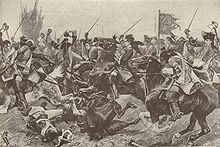
Battle of Malplaquet 1709, woodcut by R. Canton Woodville
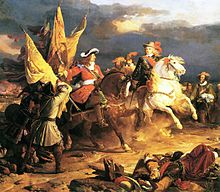
Philip V and Marshal Vendôme after the Battle of Villaviciosa 1710

James Fitzjames, son of James Stuart
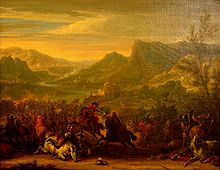
Jean Baptiste Martin: The Battle of Calcinato in the Museum of Military History
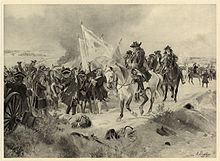
The Duke of Marlborough at the Battle of Ramillies, engraving from 1890.
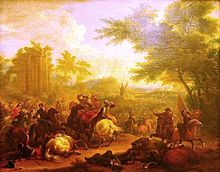
Jean Baptiste Martin: The Battle of Cassano (Museum of Military History)
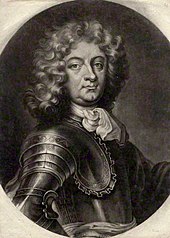
Henri de Massue de Ruvigny, Earl of Galway
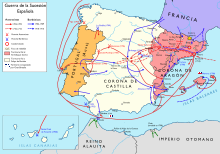
Campaigns during the war; arrows characterize the military advances, red line Habsburgs, blue lines Bourbons
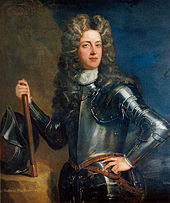
John Churchill, 1st Duke of Marlborough

Louis-Joseph de Bourbon, Duke of Vendôme

Marshal Claude Louis Hector de Villars
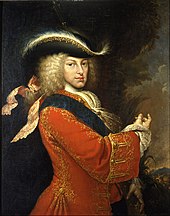
Philip V of Anjou in court dress

Jacob van Schuppen: Prince Eugene of Savoy, oil on canvas, 1718. The painting hangs in the Vienna Belvedere on permanent loan from the Rijksmuseum Amsterdam.
Search within the encyclopedia